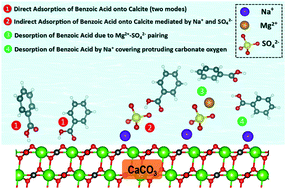Ion-specific interactions at calcite–brine interfaces: a nano-scale study of the surface charge development and preferential binding of polar hydrocarbons†
Abstract
This research provides an atomic-level insight into the synergic contribution of mono- and divalent ions to interfacial characteristics of calcite surfaces exposed to electrolyte solution containing organic compounds. The emphasis was placed on the ionic interactions responsible for charge developing mechanisms of calcite surfaces and also the capacity for adsorption of polar hydrocarbons, represented by benzoic acid (BA), at different brine compositions. For this purpose, molecular dynamics (MD) simulations were employed to explore the interplay of the main constituent ions of natural brines (Na+, Cl−, Mg2+, and SO42−) and BA at the interface of CaCO3. It was observed that surface accumulation of Na+ cations produces a positively charged layer immediate to the basal plane of calcite, validating the typical positive surface charge of carbonates reported by laboratory experiences. Meanwhile, a negatively charged layer appears beyond the sodium layer as a result of direct and solvent-mediated pairing of anions with Na+ cations lodged on the calcite substrate. In this process, sulfate adsorption severely diminishes surface charge to even a negative value in the case of a SO42−-rich solution, providing an interpretation for the measurements reported in the literature. Our results revealed the inhibition of direct binding of BA molecules onto the calcite surface through complexation with protruding oxygen atoms of basal carbonates by the residing Na+ cations. Further, we noticed the sulfate-mediated pairing of BA molecules to the Na+ layer, which in effect intensifies surface adsorption of BA. However, BA–SO42− interaction is considerably reduced by magnesium cations shielding sulfate sites in the Mg2+-augmented brine. The findings presented in this study are of fundamental importance to advance our microscopic understanding of interfacial interactions in brine/oil/carbonate systems; with broad scientific and applied implications in the context of mobilizing organic contaminants trapped in aquifer sediments and enhancement of hydrophilicity of subsurface oil-bearing carbonate reservoirs by injecting ion-modified brine solutions.

- This article is part of the themed collection: 2020 PCCP HOT Articles


 Please wait while we load your content...
Please wait while we load your content...